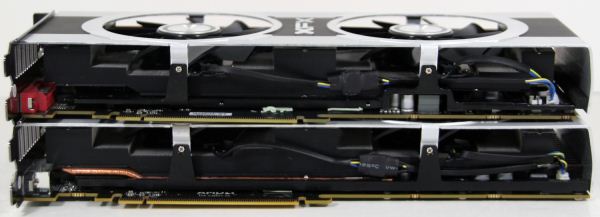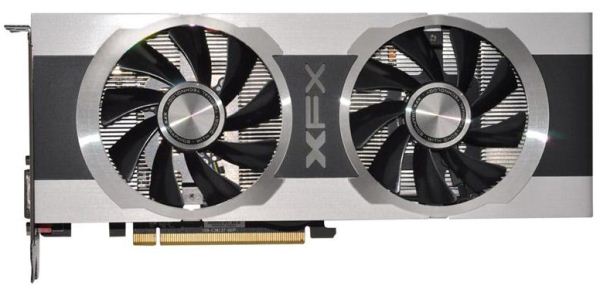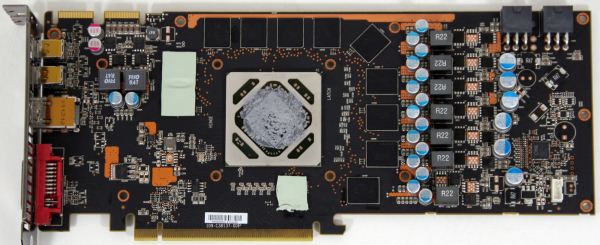AMD Radeon HD 7950 Review Feat. Sapphire & XFX: Sewing Up The High-End Market
by Ryan Smith on January 31, 2012 9:02 AM ESTMeet the XFX R7950 Black Edition Double Dissipation
Our second partner card of the day is XFX’s R7950 Black Edition Double Dissipation. Like the 7970 Black Edition Double Dissipation we reviewed earlier this month, the 7950 BEDD is a factory overclocked card (Black Edition) using XFX’s Double Dissipation cooler.
Starting with the overclock, XFX is shipping the 7950 BEDD with a core clock of 900MHz and a memory clock of 5.5GHz. This represents a 100MHz (12.5%) core clock overclock and 500MHz (10%) memory clock overclock, putting it just shy of the 925MHz core clock the 7970 ships at.
In terms of construction like all of the other 7950 cards launching today XFX is using AMD’s 7950 PCB. This means the PCB measures 10.25” long and features 2 6pin PCIe power sockets towards the rear of the card, while at the front the card uses the AMD standard port configuration of 1 DL-DVI, 1 HDMi, and 2 mini-DisplayPorts. The one notable deviation here from the Sapphire card is that XFX has not included a BIOS selection switch, so the card lacks any kind of ability to easily recover from a bad BIOS flash, and if unlocking proves viable it would not be a good candidate for the process.
Meanwhile cooling is provided by XFX’s Double Dissipation cooler. This is the same heatsink and fan assembly we saw with the 7970 BEDD, which makes this an open air cooler using a pair of fans to push air along an aluminum heatsink running almost the entire length of the card. Because it’s the same assembly, the shrouding for the card sticks out over the end of the PCB, negating the benefit of the shorter 7950 PCB and making the card 10.65” long just like the 7970 BEDD.

Top: 7950 BEDD. Bottom: 7970 BEDD
Do note that while it uses the same fan and heatsink assembly, Double Dissipation does not mean it uses the same vapor chamber assembly to transfer heat from the card. Where the 7970 BEDD used a fairly large vapor chamber, the 7950 BEDD uses a much smaller vapor chamber that only makes contact with roughly half of the heatsink, meaning that heat isn’t being transferred to the extremities of the heatsink nearly as well on the 7950 BEDD. Furthermore the aluminum plate covering the RAM and MOSFETs is poorly sized, leaving parts of the RAM chips (and their thermal pads) exposed. We’ll see how this plays out when we get to our testing, but the 7950 BEDD is clearly not as well built as the 7970 BEDD.
Rounding out the package is the same collection of extras that we saw in the 7970 BEDD. Inside you’ll find the usual driver CD and quick start guide, along with a metal XFX case badge, a mid-length CrossFire bridge, and a passive HDMI to SL-DVI adaptor. All of this is packed in one of XFX’s pleasantly small boxes, which doesn’t use much more space than the card itself.
The MSRP on the 7950 BEDD is $499, $50 over the MSRP for a regular 7950 and making it one of the more expensive 7950s launching today. XFX is offering a base 2 year warranty on the 7950 BEDD, which can be extended to a lifetime warranty by registering the card within 30 days of purchasing it.












259 Comments
View All Comments
nissangtr786 - Wednesday, February 1, 2012 - link
At the end of the day the 7970 and 7950 are great cards. They are like going from a 65nm pentium 4 to a 45nm core 2 duo in terms of performance per watt. Yes AMD may have not cranked the power consumption like amd do but performance per watt or gflops per watt it is basically double or even better then the last generation 40nm cards.Imagine 10000 40nm gtx 580 running in the world or 10000 7950 running in the world. Saving 160w more each person with similar person. 160w is a lot of power enough to run nearly an m17x r3 with 6970m.
160w multiplied by 10000 people = 1600000 watt difference for same performance of a gtx 580 and 7950. Thats 1.6m watts in simple terms more to game. If process and architecture changes of cpus and graphics cards didn't happen we would still have pentium 4's running at 3.8ghz with 6800 utras taking nearly as much power to run as an i7 3960x and 7970. Also idle watts usage go down every die shrink.
JNo - Thursday, February 2, 2012 - link
I'm surprised you didn't give the Sapphire a Gold Editor's choice award.It is pretty much awesome in every respect and I don't see any drawbacks.
No I don't work for Sapphire but this is the card I'd buy tomorrow (if I really needed it/had more money!)
Finally - Thursday, February 2, 2012 - link
Sapphire did do their homework. I find it astonishing that they were the only ones to consider undervolting, while also overclocking their product. Hats off!chizow - Thursday, February 2, 2012 - link
No, Tahiti is competing with the expectations of a new generation of hardware, expectations they clearly failed to meet. You don't ask for flagship prices when all you bring to the table is refresh performance of 14 month old last-gen parts. If you don't think so, but hey np, I have a copy of Madden 2010 you can buy for $60.How are my expectations too high? More like your expectations are too low if you were impressed with Tahiti. 15-25% faster than the last-gen flagship? Is that a joke? Once again, next-gen expectations commanding flagship prices should be AT LEAST 50% before anyone considers buying. Y'know, the same speed bump that "clusterfk" Fermi was over the last-gen parts...... Once again low expectations of AMD fans just used to being mediocre I suppose....
And to disprove your nonsense again with historical fact, Nvidia did have the fastest card in 2010 with GTX 480, but instead of raising the prices, they kept it the same with the GTX 580. They've done this in the past as well with the GTX 280 > GTX 285. They don't raise prices on refreshes, they also don't raise prices on flagships on new generations because they learned their lesson with GTX 280 after the original pricing fiasco.
chizow - Thursday, February 2, 2012 - link
Wrong again.The rebates were funded by Nvidia for price protected "exclusive" partners in NA and EU markets. At the time, that was EVGA, BFG and XFX.
The partners only sent out the rebate because they received the bulk of payment after shipping to retailers, but only with Nvidia's green light. Nvidia also directly funded/reimbursed or promised more inventory using the credited difference for any existing stock in the channel when they officially dropped the price of the GTX 280 from $650 to $500 and the GTX 260 from $450 to $350. Prices on the top two cards have stayed virtually the same since.
But yes, AMD is setting themselves up for a similar fall. If they priced the 7970 the same as the previous flagships, $500. No one would care that much. If they priced the 7950 the same as their previous 2nd tier, $380-400. No one would care that much.
But they got greedy. For what? 15-25% improvement on a new architecture, full node, and 14 months? History is due to repeat itself, and not in AMD's favor. At least in Nvidia's case, the GTX 280 actually warranted its pricetag relative to last-gen parts. You can't even say that about the 7970.
chizow - Thursday, February 2, 2012 - link
Well if a $300 card is priced where it should be and performs the same as AMD's $450 card something will certainly have to budge.Unless Nvidia decides to just refresh their old parts on 28nm and prices everything the same for a 5-10% increase in performance.
In that case, we can all just not buy video cards this generation because nothing will be worth buying and we can stop pretending these new cards are some awesome new innovation.
chizow - Thursday, February 2, 2012 - link
They're still $500 because demand is still strong, its close to EOL, and people still find value in Nvidia parts over AMD.They'll drop the prices to sell off the last few in the channel when they replace the part with something better, but in the meantime, AMD hasn't given any reason for them to slash the prices due to their greedy pricing on the 7950.
Again, this is a departure from past launches where AMD did price their parts sensibly and forced Nvidia to lower prices on its flagship cards (GTX 285 etc).
4 of 11 out of stock is good? After 4 days on the market? I don't think so. I think the market has spoken given every other major launch in the last few years on a high-end SKU like this has resulted in OOS for about a month.
Demand for this part is soft, and at its price/performance that's no surprise and really shouldn't be.
chizow - Thursday, February 2, 2012 - link
Really? So being the highest-end SKU that AMD produced and within 10-15% of the fastest single-GPU on the planet, it wasn't a high-end card? And I guess AMD didn't have any high-end cards that generation?And "pricing ALWAYS based on performance relative to the competition". So the RV770 coming within 10-15% of the GTX 280 which already launched for $650 and was selling briskly because it deserved that pricing relative to last-gen (9800GX2, 8800GTX) and AMD pricing this part for $299 made sense based on performance relative to the competition? Really?
You're wrong. Stop posting LMAO. RV770 was a price mistake on AMD's part, a mistake they've been trying to correct ever since. Now Nvidia has a chance to return the favor because the 7970/7950 are going to be in a similar position due to the fact they're mispriced based on last-gen metrics.
chizow - Thursday, February 2, 2012 - link
Newsflash: if you want the newer part, you actually expect better performance for the same price compared to parts that have been out for over a year.Welcome to my used car lot where I sell old cars for brand new prices.
chizow - Thursday, February 2, 2012 - link
And that's exactly what's wrong with their pricing, an error that will be obvious once its competing against the products its supposed to be competing with.By your same flawed logic, graphics cards would be thousands of dollars as every incremental increase would incur an increase in price without limits.